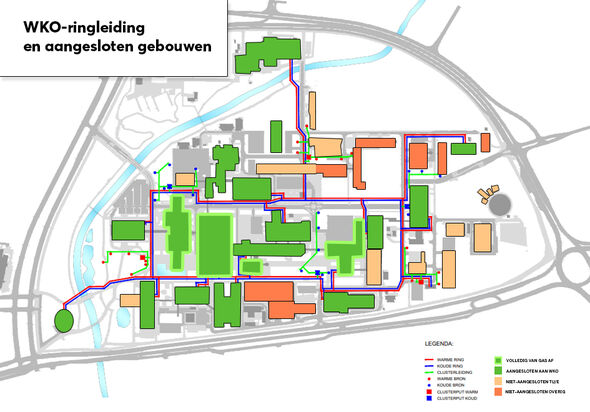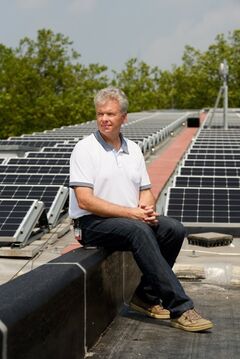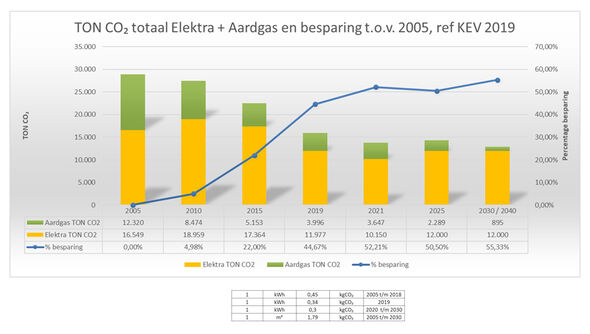
Foresight offers perspective in times of gas crisis
Gas prices are skyrocketing and even for the TU/e campus, which has already stopped using gas for quite some buildings, costs are mounting. More buildings will soon be getting rid of gas at an accelerated pace. But this raises the question: will the energy network be able to handle everything running on electricity? These are the questions that energy management consultant Thijs Meulen has been looking into, for a campus that is in the midst of a transformation.
Back in 2002, TU/e literally built a foundation in the ground for a gas-free future. The thermal storage system (wko) located underneath the campus has 32 sources that can supply buildings with heat, cooling or a combination thereof via two circuits. The system, that celebrates its 20th anniversary this year, is unique in the Netherlands. The fact that this system allows for simultaneous supply of heat and cooling makes it suitable for all types of buildings. Therefore, the goal is to connect the entire campus to the thermal storage system.
“We have enough capacity to do so”, explains Meulen. “We could theoretically supply the buildings with 2,000 cubic meters of water per hour. In the summer, we use around 1250 cubic meters for buildings that are already connected. (In the summer, the system has to work harder than in the winter, because the campus mainly needs cooling, Ed.) Thus, we have enough spare capacity to connect new buildings and the existing buildings that are yet to be connected, including labs, without any difficulty.” The 32 sources provide even more capacity than initially anticipated, because new buildings in particular are very well insulated.
19 buildings are currently connected to the thermal storage system, four of which are completely gas-free: Atlas, Flux, Metaforum and Ceres. “Neuron, Qubit and Gemini will also become gas-free and there are plans to get rid of gas at the Auditorium, Cascade and Helix sooner than we had scheduled, because of the current situation in the energy market.” Because even though so many buildings have already gotten rid of gas, the cost of the gas that is still being used on campus (including in buildings used by third parties) has already surpassed the budgeted amount twelve times in the last quarter.
Gazprom
The reason is that as of October 1, TU/e terminated its contract with Russian energy supplier Gazprom, in line with the EU’s fifth sanction package. The university entered into a new contract with GreenChoice through a tender process. As a result, the price for a cubic meter of gas jumped from 15 cents to 1,80 euros. Meulen has set himself the goal of arriving at an average price of under two euros per cubic meter of gas for 2023. For purchasing purposes, the year is split into units of 5 percent, allowing him to spread the risk over those 20 parts.
On the days that he can purchase gas, he has to respond to the offered price within 10 minutes. “I make sure I’m ready at 10:30 a.m. so that I can agree to that price immediately – in accordance with the established methodology. If the cost per cubic meter is favorable, i.e., under two euros, I can also choose to purchase 10 percent, for example, instead of just 5 percent of the total. In that case, if we get offered a price of over two euros later in the year, I have the option to skip it.” Prices fluctuate dramatically. “On September 13, for example, the price of gas was 1.72 euros per cubic meter. Two days later, it rose to 2.41 euros."
Government support
With an annual consumption of 2.6 million cubic meters of gas (including third parties on campus), the difference between 1.80 euros or 2.40 euros is substantial. Therefore, Meulen hopes for government support. The price ceiling of 1.50 euros per cubic meter that was announced by The Hague does not apply to the university. “Even the local baker will be missing out on it”, said Meulen, who is displeased with what he considers to be a weak response from Dutch politics. “There’s not a single regulation that currently applies to us. There will be, but exactly what it will entail is still unknown. There will probably be an energy tax reduction, but at the same time, as of January 1, the current VAT rate of 9 percent will be replaced by the regular rate of 21 percent. The compensation on the energy tax won’t make up for that; they’d have to set it at zero. In fact, I don’t understand why they choose to do this, because even with the 9% VAT rate, they’re now making much more money than before because of the high prices. And it’s precisely that VAT that makes a huge difference for companies and organizations.”
What makes the situation even more painful, according to Meulen, is that organizations and municipalities that acted quickly and broke with Gazprom immediately when the government asked them to do so, were put to unnecessary expense. Only later, the government realized that leaving the company only resulted in filling the coffers of Russia, because the gas that became 'available' could be sold again for a much higher price. Therefore it offered organizations and municipalities the option to postpone until January 1. "It was already too late for us. It would have saved the university a lot of money if we could have waited those few months before making the switch.” Meanwhile, the government has extended the postponement with three more months, until March 2023. Nevertheless, for reasons of principle, Meulen is happy that TU/e took the step to break with Gazprom.
It must come as no surprise that the university now wants to speed up the process of becoming gas-free. That is why the plans to connect the Auditorium and Helix to the thermal storage system have been moved forward. But the price for electricity is currently also considerably higher than before because some of it is generated with gas. “We were able to fix the price for electricity for the whole year in May. We did that because we saw that those prices were also rising dramatically.”
Financial consequences
The price increase for electricity and the unforeseen price explosion for gas will have a significant effect on TU/e, Director of Finance & Control Ruud van de Donk lets Cursor know by mail. ‘We expect a substantial increase in costs as of the fourth quarter of 2022. The effect will be a lower financial result. We will still be able to compensate for this in 2022 thanks to a few unexpected windfalls. This year, we are still in the black. In 2023 however, the additional costs will be so high that we are predicting a negative result.’
Therefore, the university will have to use part of its reserves to cover that loss. ‘We would have liked to avoid that, because we would prefer to use 100 percent of those reserves for TU/e’s development in the coming years: not just for education and research, but also for the modernization of our campus and for digitalization.’ The consequence of the additional costs now being incurred for energy is less financial space for the university’s strategic ambitions, Van de Donk adds.
In order to get rid of gas on campus at an accelerated pace, several investments must be made. These were already planned as part of the university’s sustainability efforts and are now being fast-tracked, where possible. ‘Financially, the extra investments outweigh the extra gas costs; on balance, this does not result in any financial disadvantages.’
Van de Donk also hopes for compensation from the government. ‘Together with other Dutch universities, TU/e has entered into consultations with the central government to discuss whether financial compensation for the increased energy costs is possible. This is not a matter of course. For example, although we did receive some price compensation this year, it was wholly insufficient to cover the cost increases TU/e is facing, even if we do not consider the increased gas prices.’
CO₂ reduction
Electricity consumption on campus will increase in the coming years, because in addition to the new connections to the thermal storage system, a new lab building will be constructed, some research projects will require more electricity and gradually more charging points will be installed on campus, Meulen says. A short time ago, there was some doubt as to whether the power grid would be able to handle that. National grid operator TenneT eventually managed to free up space. “We have now applied for an expansion with grid operator Enexis, for double the capacity of what we use now.”
At the same time, the university is trying to reduce consumption at all possible levels, not just for financial reasons, but also for the sake of sustainability. “The climate agreement states that as a public institution, we have to reduce our CO₂ emissions by 55 percent by 2030. As things stand, we will certainly be able to accomplish that. In fact, if you were to include the Covid-19 period, we’d have already made it.” There are multiple ways to achieve CO₂ reduction.
Gas has a constant emission of 1.79 kilograms per cubic meter; electricity has a variable emission, which is becoming more favorable due to the increase in renewable energy. Current calculations assume an emission of 0.3 kilograms per kWh. So, by switching from gas to electricity, you automatically reduce some of your emissions. Once the university is running entirely on electricity, emissions will therefore continue to decrease automatically. “Because we’re getting rid of gas, we could, in theory, increase our electricity consumption from 34,000 MWh to 40,000 MWh and still achieve that 55 percent CO₂ reduction.”
Meanwhile, the university also wants to cut down on consumption. Smart lighting can make a big difference in that regard. “In Atlas, our basic lighting level is 100 lux. Under normal circumstances, standards require that a workplace has 500 lux, but that’s not necessary in this building because there is enough outside light shining in. By going from 500 to 100 lux, you save 80 percent in energy.” In addition, equipment is generally becoming more and more energy efficient, Meulen adds. “Take ventilation motors, for example. The difference between now and 10 years ago is extremely large, so by installing new motors you can also save energy.”
This is also being taken into account in new construction and renovations on campus. For example, Neuron will be equipped with smart lighting that uses sensors. “That building will also be insulated in accordance with the new standards, and the roof will be fitted with glass for extra lighting.” However, it is not possible to make these kinds of changes for every building on campus. This raises the question of whether it is worth maintaining such buildings in the future.
“Traverse is one such case", says Meulen. "That building has an energy label D, so there is much to be gained there. By replacing the ventilation motors, we can manage to upgrade to label C, but if we want to get all the way to A, we have to fix the entire facade of the building. The question is whether this building is still in line with the real estate strategy, and based on that, we will determine if it’s economically feasible.”
Energy guzzlers
The same concerns arise for buildings that are now used by Fontys, but that will soon come back into the possession of the university. “Among these are buildings that are almost no longer usable for TU/e. We will have to figure out what to do with it, but another group within Real Estate is working on that.”
Other than that, there are practically no real energy guzzlers on campus anymore. “Except for the sports center. The new section that is currently being built is gas-free, but we still have to do a complete overhaul of the rest of the building. We are looking into how we can make preparations during the construction, so we can also make the existing building gas-free at a later stage. However, the swimming pool is one of the most economical pools in the Netherlands; we can also use it to dispose of all the excess heat from the thermal storage system.”
Spectrum, Helix and Cyclotron also have a high consumption. “Those three together account for half of the campus’ energy consumption.” Why is that? “Helix, for example, has five hundred fume cupboards, which need extraction to dispose of toxins. If the windows of those cupboards are left open, all the conditioned air from the buildings is blown out.” It is a factor that has a great influence on campus consumption and is simultaneously very difficult to control: people’s behavior. In Helix, pilots have been conducted to try to solve this, for example, by making the cupboards close automatically. However, the problem was that it could lead to an unsafe situation if a cupboard were to close when someone walked past with bottles full of toxic substances. So that pilot was ultimately unsuccessful. In a joint project with the department, Real Estate is currently looking into the option of getting fume cupboards that are more energy-efficient.
Collaboration
Meulen often sets out to collaborate with different departments precisely in order to find sustainable solutions on campus. For example, AI-institute EAISI helps out with ideas for Neuron. “Multisensors will be installed in the building that can measure light, occupancy, particulate matter and other things like that. They in turn can use this as a case. So, it’s not only beneficial for operations, but also for research.”
Another example is the solar panels at Flux. Erwin Kessels, professor at Applied Physics, helped select the type of solar panels to be used. Four different types of panels were chosen, that all use different techniques. This way, it is possible to measure which technique yields the most energy. Meulen: “We could have simply installed ‘dumb’ panels, but for Flux, we truly decided to focus on research.”
And then there is the increasing electricity consumption on campus. “We want to get rid of the spikes in that consumption. Together with EIRES, we’re looking at how we can balance it out. There are so many technically skilled people here, and if you’ve been around here long enough, people will eventually know where to find you.”
In addition to getting rid of gas, using smart lighting, buying more economical equipment and trying to adjust people’s behavior, there is another way to cut down on consumption: generating your own sustainable energy. If you look out over the campus, you will notice that many of the roofs do not have solar panels yet. That is about to change. In 2023, new legislation will come into effect, requiring organizations that use big amounts of energy – including TU/e – to reduce their energy consumption. “If possible, all roofs must be equipped with solar panels with a payback time of less than five years. All buildings under renovation were already getting solar panels, with the exception of Neuron.”
Thermal storage system
No matter how many solar panels you would install on campus, achieving complete self-sufficiency is impossible, says Meulen. You would only be able to generate 8% of the electricity needed. However, it would generate enough energy to run the entire thermal storage system off solar panels. Connecting more buildings to that system is now the university’s number one priority. This is not very difficult and costs relatively little money, because the sources are already in place. “It was a good idea to do that at that time. Now it’s just a matter of connecting, plugging in and then we’re all set.”




Discussion